
Fundamentals
The conceptual delineation of Hair Straightening, within Roothea’s ‘living library,’ begins not as a mere cosmetic alteration but as an elemental engagement with the very architecture of a strand. It represents the purposeful modification of hair’s inherent curl pattern, transforming it from its naturally coiled, wavy, or kinky configuration into a smoother, elongated form. This fundamental understanding is rooted in the recognition that hair, in its myriad expressions, possesses a memory, a genetic blueprint that dictates its shape and flow. Hair Straightening, therefore, is the act of persuading this memory, however temporarily or enduringly, to manifest a different visual and tactile reality.
From the earliest whispers of human ingenuity, individuals have sought to influence the presentation of their hair, driven by practical considerations of manageability, cultural aesthetics, or personal expression. This foundational practice speaks to a universal human inclination to adorn and reshape the self, a deeply ingrained impulse that predates formal scientific inquiry. The basic mechanism involves overcoming the natural structural bonds that dictate curl, allowing the hair to lie flat and align more uniformly. This initial explanation lays the groundwork for appreciating the profound historical and cultural layers that envelop this seemingly straightforward physical transformation, particularly within the textured hair community.
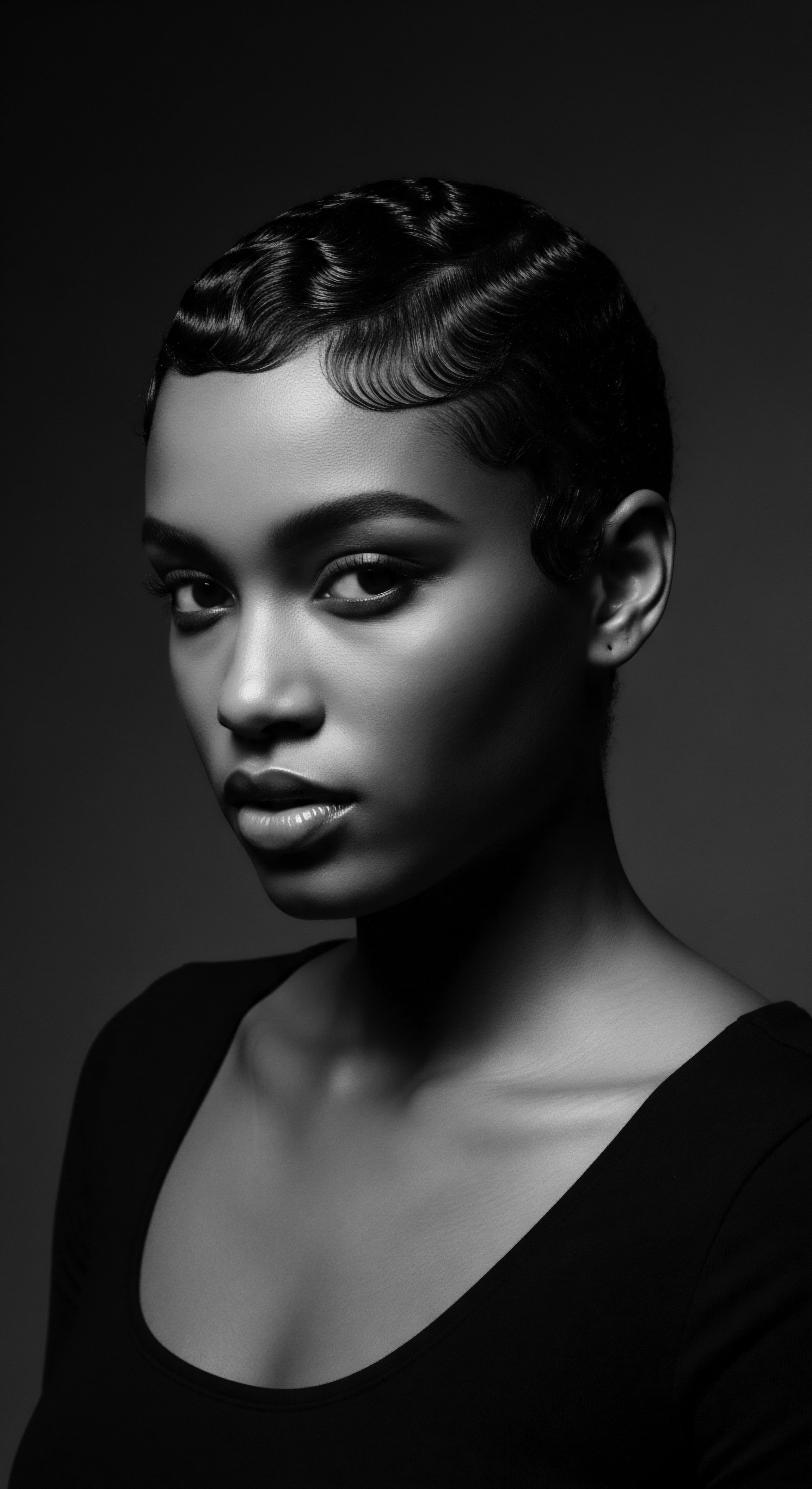
The Hair’s Natural State ❉ A Delineation of Form
To comprehend Hair Straightening, one must first appreciate the remarkable variability of hair itself. Each strand emerges from the scalp with a unique genetic predisposition, resulting in a spectrum of textures, from the gentle undulations of waves to the tightly wound spirals of coils. This intrinsic character, often termed ‘curl pattern,’ is determined by the shape of the hair follicle, the angle at which it exits the scalp, and the distribution of disulfide bonds within the hair’s protein structure. Understanding this natural diversity is paramount, as Hair Straightening fundamentally seeks to re-pattern this inherent design.
The inherent elasticity and resilience of textured hair, a legacy passed through generations, allows it to assume a multitude of shapes and styles. Its natural form is a testament to ancestral adaptation and aesthetic preference across various global communities. The initial concept of Hair Straightening thus emerges from a desire to modify this ancestral signature, either for ease of care, cultural conformity, or artistic styling.
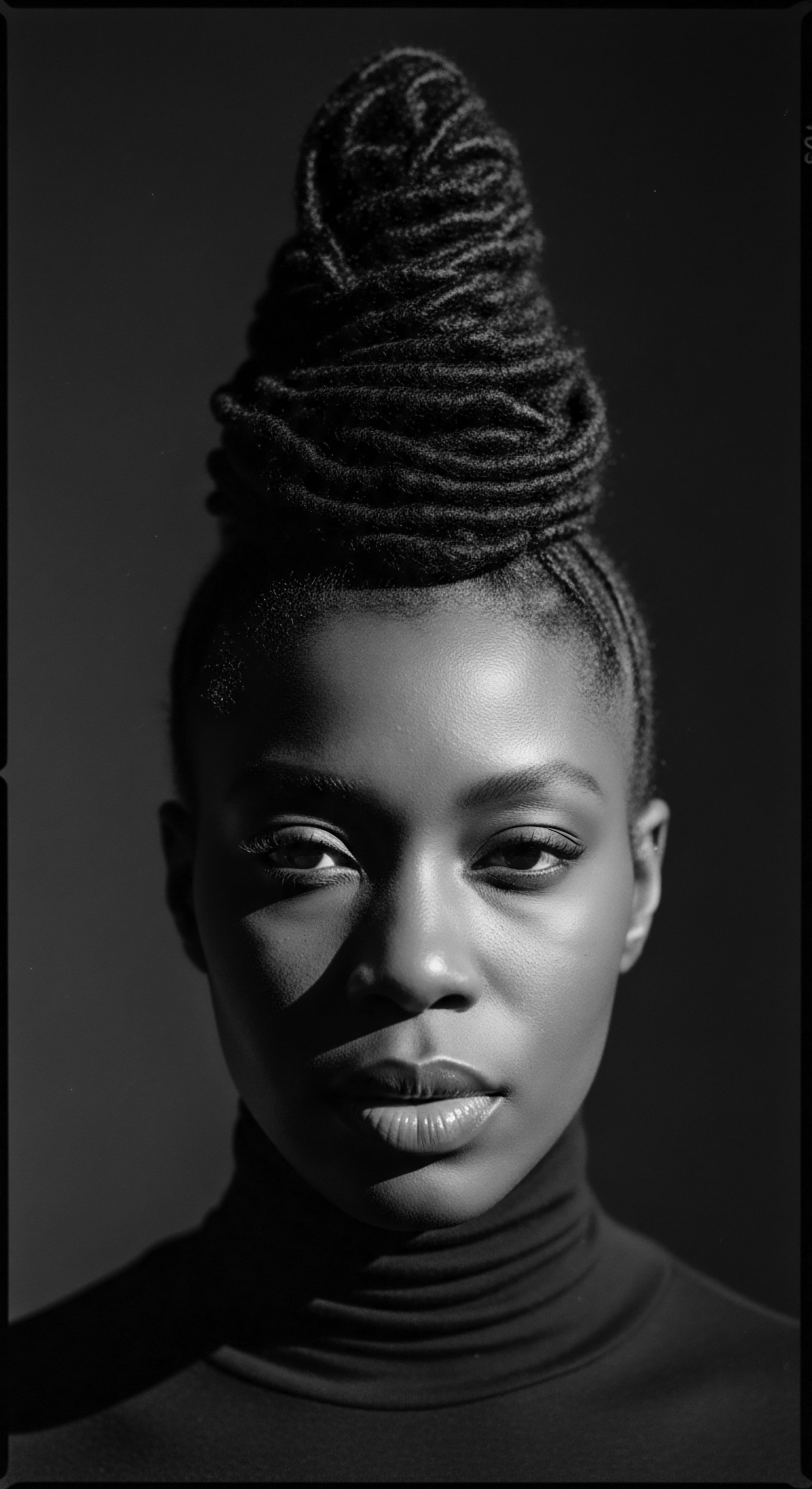
Early Modulations of Form ❉ Echoes from the Source
Long before the advent of modern chemistry or heated tools, humanity explored rudimentary methods to alter hair’s appearance. These early attempts, often rooted in ancestral practices, represent the foundational understanding of Hair Straightening. Such methods were frequently manual, relying on tension, braiding, or wrapping techniques to stretch the hair. The application of natural oils or water, followed by meticulous manipulation, could temporarily lengthen coils and waves, offering a glimpse into the hair’s potential for altered form.
Hair Straightening, at its core, represents a dialogue between human will and the hair’s inherent, ancestral design.
These initial engagements with hair’s structure were often intertwined with daily grooming rituals, community gatherings, and ceremonial preparations, highlighting their early significance beyond mere aesthetics. They speak to a collective wisdom regarding hair’s malleability and the capacity to influence its visual presentation through patient, repeated effort.
- Tension Techniques ❉ Utilizing braids, twists, or wrapping around objects to stretch the hair, a practice seen in various ancestral traditions.
- Weight Application ❉ Employing natural materials or heavy oils to gently pull down hair, encouraging elongation.
- Moisture Manipulation ❉ Applying water or plant-based infusions to soften the hair, making it more pliable for temporary straightening.
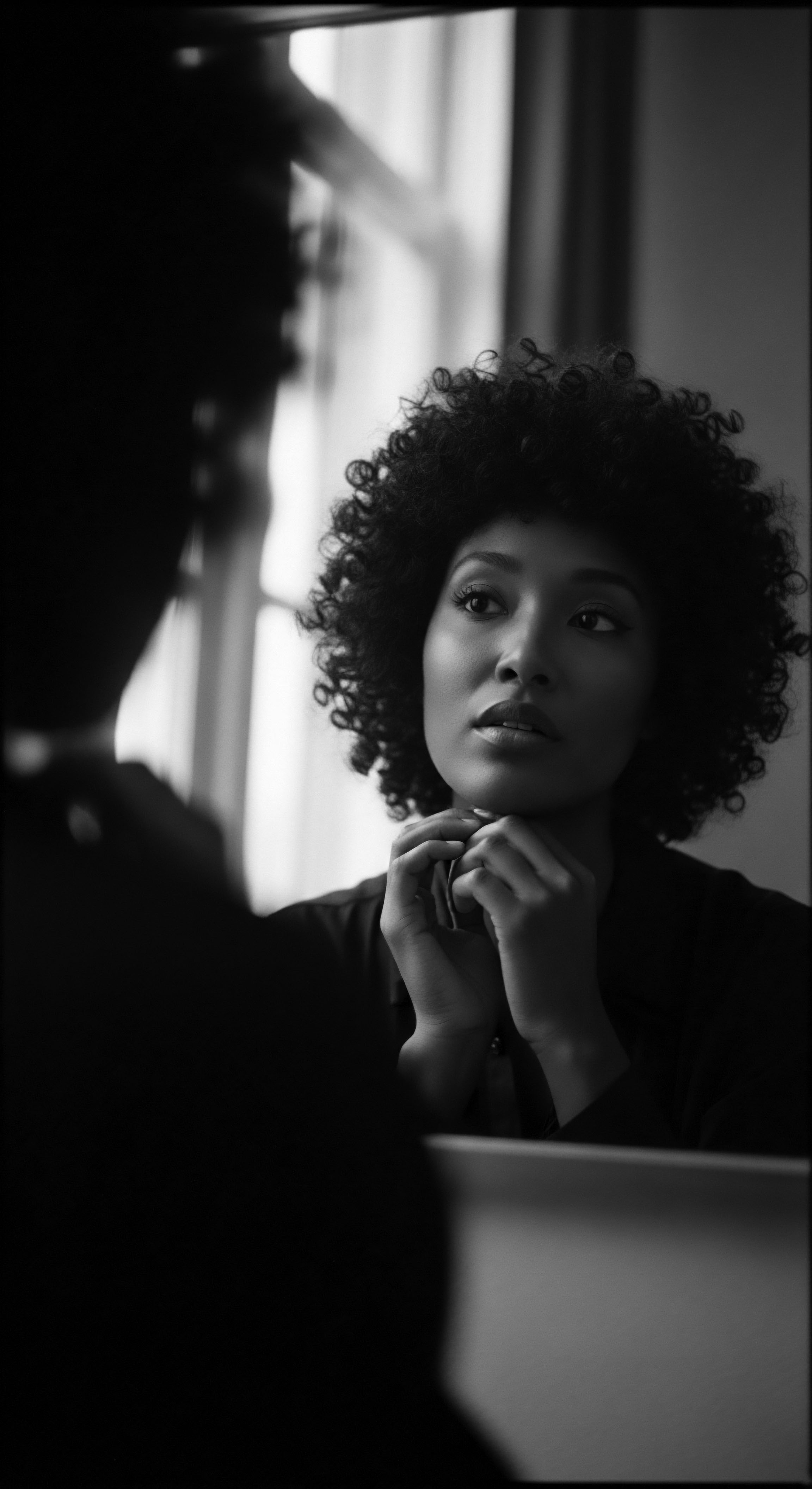
Intermediate
Moving beyond the foundational understanding, the intermediate comprehension of Hair Straightening delves into the more deliberate and impactful methodologies employed to achieve a smoother hair configuration. This level of explanation clarifies the distinction between temporary physical alterations and more enduring chemical reconfigurations, each bearing its own historical lineage and cultural weight. The meaning of Hair Straightening expands here to encompass the tools and substances developed over centuries to effect these changes, particularly as they relate to the nuanced needs and experiences of textured hair.
This phase of understanding acknowledges that Hair Straightening is not a monolithic practice but a spectrum of interventions, from the fleeting effects of heat to the more profound and lasting impact of chemical compounds. It also begins to unveil the motivations behind these choices, often intertwined with societal pressures, personal comfort, and the evolving narrative of beauty standards within Black and mixed-race communities.

Mechanical Transformations ❉ The Tender Thread of Heat and Tension
The application of heat and tension represents a significant stride in the historical journey of Hair Straightening. This method temporarily reshapes the hair by disrupting its hydrogen bonds, which are highly susceptible to changes in temperature and moisture. When heat is applied, these bonds temporarily break, allowing the hair to be molded into a straight form.
As the hair cools, the hydrogen bonds reform, locking the new, straightened shape into place until the hair is exposed to moisture again. This understanding is critical for appreciating techniques like blow-drying, flat ironing, and the historically significant pressing comb.
The pressing comb, in particular, holds a poignant place in the heritage of Black hair. It was a tool that, while offering a means to achieve a desired aesthetic, also symbolized a complex interplay of self-expression, societal conformity, and economic opportunity. Its widespread use in the early 20th century provided a means for Black women to align their hair with prevailing beauty standards, often for professional advancement or social acceptance, yet it also carried the risk of heat damage and the psychological weight of altering one’s natural ancestral crown.
| Technique Hair Wrapping/Tension Methods |
| Historical Context/Cultural Relevance Ancient African and diasporic practices for stretching and protecting hair, often for ceremonial or daily wear. |
| Mechanism of Action Physical stretching and manipulation of hair fibers to elongate coils without heat. |
| Technique Hot Comb/Pressing Comb |
| Historical Context/Cultural Relevance Popularized in the late 19th/early 20th century, particularly among Black women in the United States; a tool for achieving temporary straightness. |
| Mechanism of Action Direct heat application to break hydrogen bonds, followed by combing tension to smooth and straighten the hair. |
| Technique Blow Drying with Tension |
| Historical Context/Cultural Relevance A more modern evolution of mechanical straightening, becoming widely accessible in the mid-20th century. |
| Mechanism of Action Combined heat and airflow to dry and stretch hair, temporarily altering hydrogen bonds. |
| Technique These mechanical methods represent humanity's enduring efforts to influence hair's form, deeply intertwined with cultural practices and individual agency within textured hair communities. |

Chemical Reconfigurations ❉ A Historical Glimpse into Enduring Change
Beyond temporary physical alterations, Hair Straightening also involves chemical processes that permanently reconfigure the hair’s structure. This more enduring transformation works by breaking and then reforming the hair’s stronger disulfide bonds, which are responsible for the hair’s lasting shape. Once these bonds are broken, the hair can be physically straightened, and then new bonds are formed in this altered configuration, rendering the change more permanent.
The advent of chemical relaxers in the early to mid-20th century marked a significant turning point in the history of Hair Straightening, especially for Black hair. These chemical agents, initially harsh lye-based formulas, offered a more lasting solution than mechanical methods, providing a sense of liberation from daily styling routines for some, while for others, they represented a capitulation to external pressures. The journey of chemical Hair Straightening is thus a complex narrative of innovation, convenience, health concerns, and evolving identity within the textured hair community.
The journey of Hair Straightening, from ancestral tension methods to chemical reconfigurations, reflects a continuous human dialogue with the inherent character of hair.
- Lye-Based Relaxers (Sodium Hydroxide) ❉ The earliest widely available chemical straighteners, known for their strong bond-breaking capacity and potential for scalp irritation.
- No-Lye Relaxers (Calcium Hydroxide/Guanidine Carbonate) ❉ Developed as a milder alternative, though still capable of permanent alteration, aiming to reduce scalp discomfort.
- Thio-Based Straighteners (Ammonium Thioglycolate) ❉ Often used in professional settings for permanent waving or straightening, working through a different chemical pathway to break and reform bonds.

Academic
The academic understanding of Hair Straightening transcends superficial appearances, delving into its profound molecular underpinnings, its intricate historical trajectory, and its deep sociological and psychological implications, particularly for individuals with textured hair. This scholarly interpretation defines Hair Straightening as a deliberate chemical or mechanical intervention that alters the hair’s primary, secondary, and tertiary protein structures, thereby modifying its natural helical configuration to a more linear alignment. The meaning here is not merely cosmetic; it is a complex interplay of biochemical reactions, cultural forces, and individual agency within a broader societal framework.
This elucidation demands a rigorous examination of the keratin protein, the primary constituent of hair, and its complex bonding network. Hair Straightening fundamentally targets these bonds ❉ the hydrogen bonds, which are easily disrupted by water and heat; the salt bonds, which are sensitive to pH changes; and most significantly, the disulfide bonds, which provide hair with its strength and permanent shape. The chemical processes employed in straightening agents, such as alkaline relaxers or thio-based systems, operate by cleaving these disulfide bonds, allowing the hair cortex to be reshaped. Subsequent neutralization or oxidation then reforms new disulfide bonds in the hair’s straightened configuration, rendering the alteration semi-permanent or permanent.

The Molecular Choreography of Straightening ❉ An Elucidation
At the microscopic level, the hair fiber is a marvel of biological engineering. Its shape, whether tightly coiled or gently undulating, is dictated by the distribution of keratin proteins and the configuration of their disulfide bonds. These covalent bonds, formed between sulfur atoms in cysteine amino acids, act as the hair’s internal scaffolding, providing its inherent strength and memory of curl. Hair Straightening agents, particularly chemical relaxers, function as reducing agents, initiating a process known as reduction-oxidation (redox).
For instance, in alkaline relaxers, such as those containing sodium hydroxide (lye), the high pH environment causes the hair shaft to swell, making the disulfide bonds more accessible. The hydroxide ions then facilitate the breakage of these bonds through a process called Lathioninization, converting cystine into lanthionine and cysteine. This irreversible alteration of the disulfide bond network allows the hair to be physically straightened.
Once the desired straightness is achieved, the hair is rinsed and neutralized, and new, albeit fewer and differently aligned, bonds are formed in the straightened configuration. This intricate chemical transformation underpins the enduring nature of relaxed hair, setting it apart from temporary mechanical methods.

Echoes of Assimilation and Agency ❉ The Hot Comb’s Legacy
The historical trajectory of Hair Straightening within Black communities offers a profound case study in the intersection of personal identity, societal pressures, and technological innovation. The hot comb, though not invented by her, was popularized and widely distributed by entrepreneurs like Madam C.J. Walker in the early 20th century.
Its advent provided a relatively accessible and temporary means for Black women to straighten their hair, offering a new avenue for styling and presentation. This tool, often heated on a stove and carefully passed through the hair, became a complex symbol.
The motivations for adopting hot comb styling were manifold and deeply personal. For some, it represented a practical solution for manageability, especially for tightly coiled textures that could be challenging to style with existing methods. For others, it was a pathway to social mobility and acceptance in a society that often penalized Black women for their natural hair, viewing it as “unprofessional” or “unruly.” As Ayana Byrd and Lori Tharps illuminate in their seminal work, Hair Story ❉ Untangling the Roots of Black Hair in America (Byrd & Tharps, 2001), the hot comb provided a means to conform to dominant beauty standards, which historically privileged straight hair.
This conformity, however, was often a strategic act of survival and agency, allowing Black women to navigate hostile social and economic landscapes. The hot comb was not merely a styling tool; it became a conduit for negotiating identity, belonging, and resistance within a racialized context.
The historical use of Hair Straightening tools like the hot comb reveals a complex interplay of adaptation, aspiration, and agency within Black hair heritage.
The widespread adoption of the hot comb illustrates a powerful sociological phenomenon ❉ how beauty practices can become deeply intertwined with racial politics and economic opportunity. While it offered a temporary respite from the perceived limitations of natural hair in a white-centric society, it also introduced a new set of challenges, including heat damage and the constant pressure to maintain a straightened appearance. The legacy of the hot comb, therefore, is a testament to the resilience and adaptability of Black women, who consistently found ways to define beauty and navigate self-presentation despite external constraints.
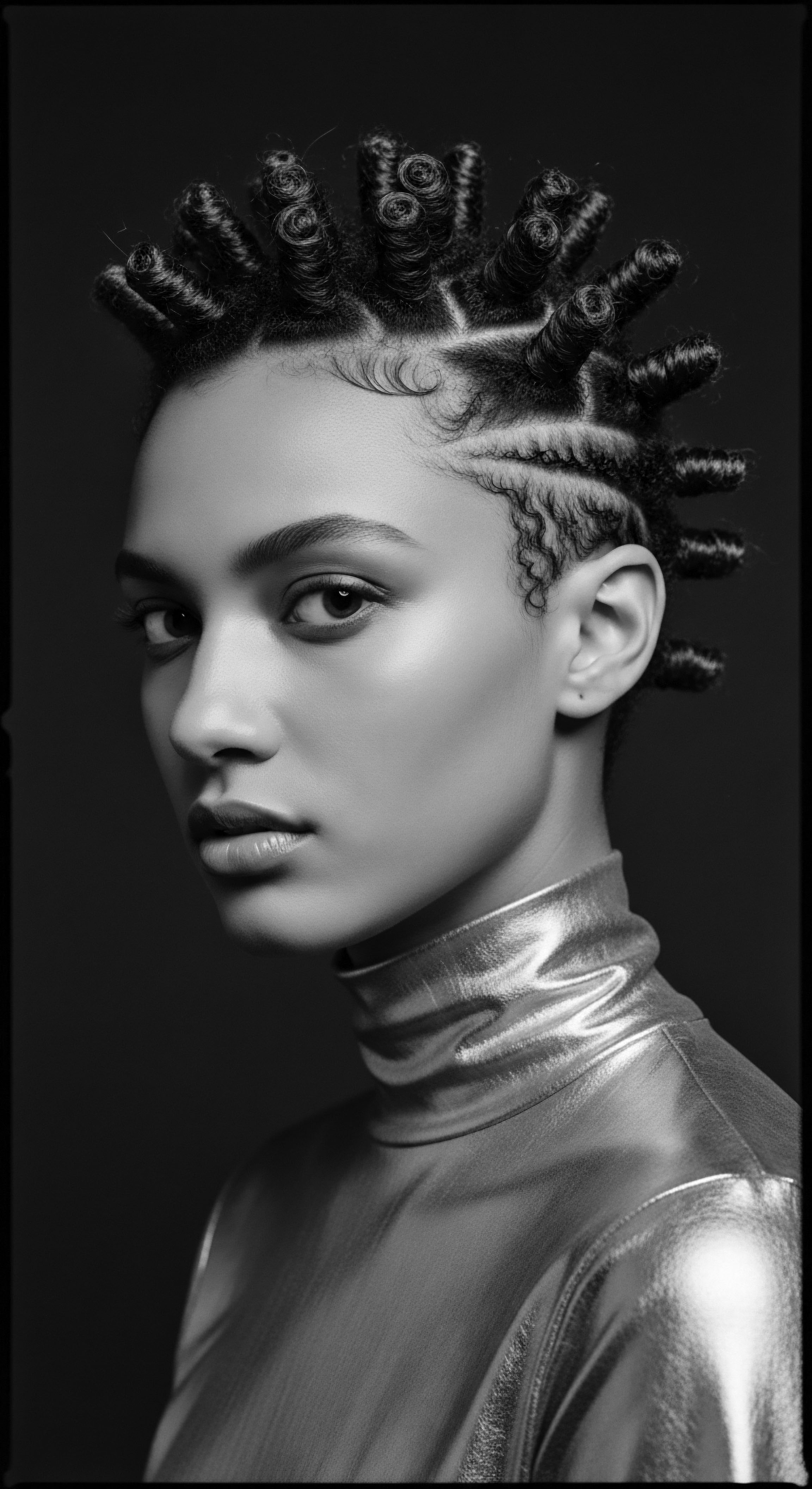
The Chemical Alteration ❉ A Delineation of Its Mechanism and Cultural Resonance
The introduction of chemical relaxers marked a more permanent shift in the landscape of Hair Straightening. These formulations, whether lye-based (sodium hydroxide) or no-lye (calcium hydroxide, guanidine carbonate), operate by chemically altering the hair’s disulfide bonds. The high alkalinity of these products swells the hair cuticle, allowing the active ingredients to penetrate the cortex and break these strong bonds. This process is irreversible, meaning the hair remains straightened until new growth emerges from the scalp.
The cultural impact of chemical relaxers on Black hair experiences is profound and enduring. For decades, relaxers became the dominant method for straightening hair within many Black communities, offering a perceived ease of styling and a more lasting adherence to Eurocentric beauty ideals that permeated media and professional spaces. This widespread acceptance, however, came with a complex set of implications. On one hand, relaxers provided convenience and a sense of liberation from time-consuming daily styling for many.
On the other, they contributed to a narrative that often devalued natural textured hair, leading to internal conflicts about identity and self-acceptance. Moreover, the health risks associated with chemical relaxers, including scalp burns, hair breakage, and potential long-term health concerns, became a significant concern within the community, sparking conversations about hair health and well-being.
The evolution of chemical Hair Straightening, from early, harsh formulas to more refined, albeit still potent, versions, mirrors a larger societal dialogue about beauty, race, and health. The shift towards the natural hair movement in recent decades can be seen, in part, as a direct response to the legacy of chemical straightening, a reclamation of ancestral hair forms, and a redefinition of beauty on one’s own terms.
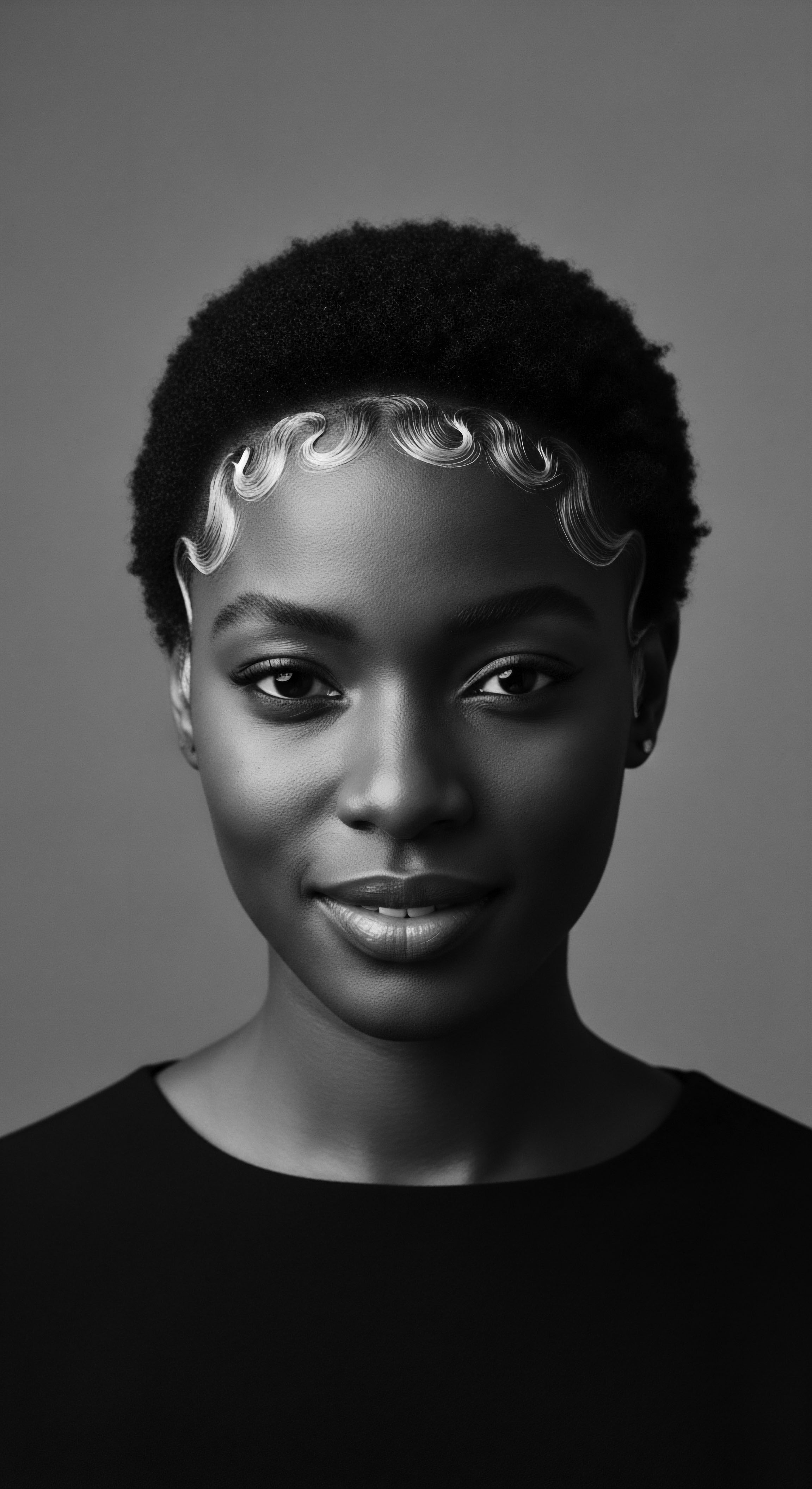
Societal Reverberations ❉ Hair Straightening and the Shifting Contours of Identity
The meaning of Hair Straightening extends far beyond its chemical or mechanical processes; it is deeply interwoven with societal structures, racial dynamics, and the very construction of identity. For Black and mixed-race individuals, the choice to straighten hair has historically been, and often remains, a complex decision influenced by external pressures and internal desires. Academic discourse on this topic frequently explores the concept of ‘code-switching’ – adapting one’s appearance, including hair, to fit different social or professional environments.
Sociological studies have consistently highlighted how hair presentation can impact perceptions of professionalism, intelligence, and attractiveness, particularly for Black women in Western societies. The pervasive nature of Eurocentric beauty standards, often propagated through media and institutional norms, has historically positioned straight hair as the ideal, creating an implicit or explicit pressure to conform. This pressure, as examined by researchers like Alana J.
Jones in her work on Black women’s hair experiences, can lead to psychological distress, body image issues, and a disconnect from one’s ancestral heritage (Jones, 2017). The act of Hair Straightening, in this context, can be interpreted as both a strategic act of survival within a biased system and a manifestation of internalized beauty ideals.
The cultural landscape surrounding Hair Straightening is, however, dynamic. The rise of the natural hair movement in the 21st century signifies a powerful counter-narrative, challenging long-held assumptions about beauty and professionalism. This movement encourages the celebration of natural textured hair in all its forms, promoting self-acceptance and a deeper connection to ancestral roots.
This shift redefines the meaning of Hair Straightening, transforming it from a presumed necessity into a conscious choice among a spectrum of styling options, often chosen for aesthetic versatility rather than societal conformity. The conversation now centers on hair health, versatility, and the freedom to choose, rather than feeling compelled to alter one’s natural state.
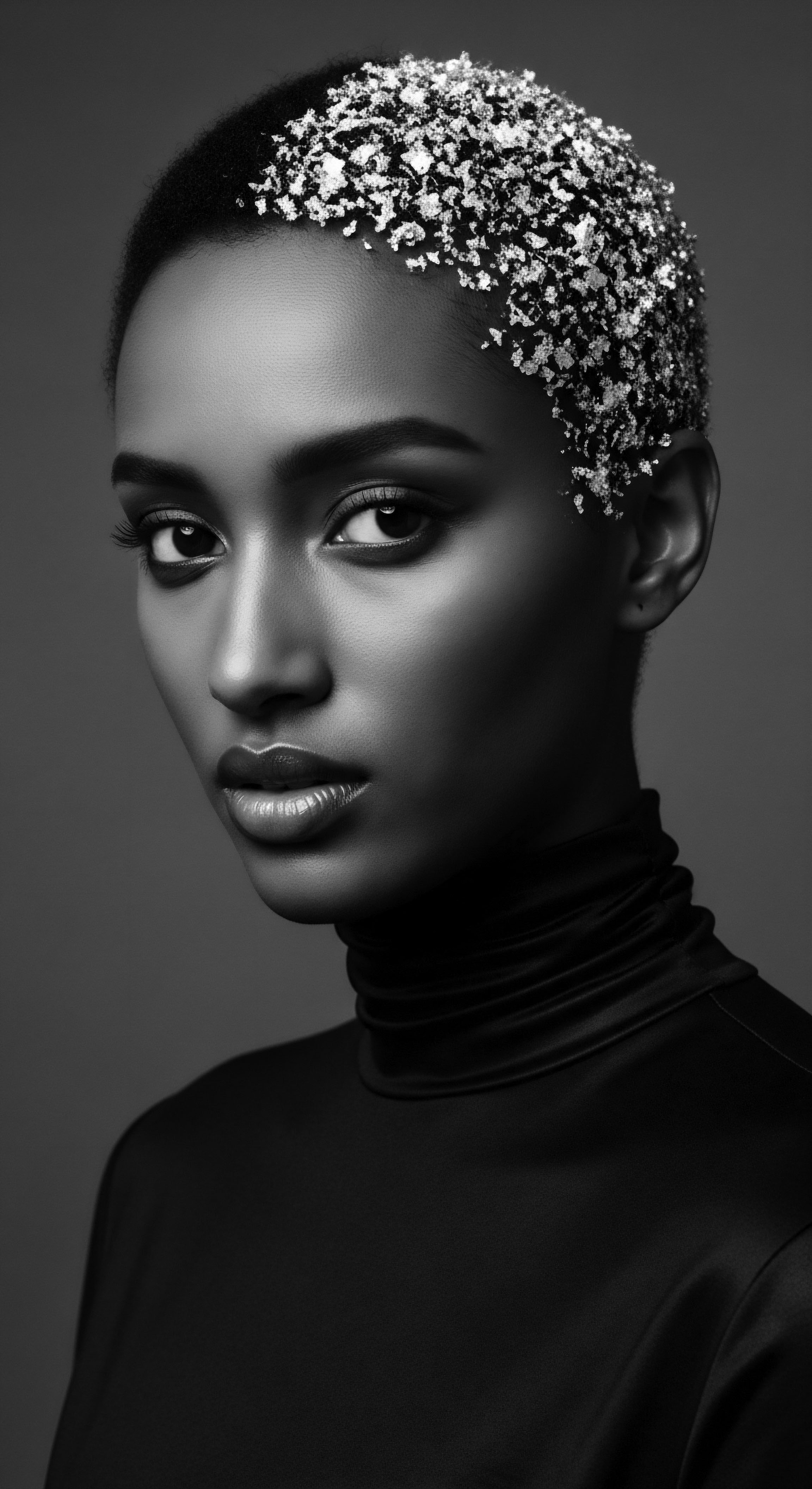
Ancestral Wisdom and Modern Science ❉ A Confluence of Understanding
The academic lens also allows for a rich dialogue between ancestral wisdom and contemporary scientific understanding of Hair Straightening. Traditional hair care practices, often passed down through generations in African and diasporic communities, utilized natural ingredients and techniques that, while not chemically altering disulfide bonds, aimed to enhance hair’s manageability, health, and elongation. These practices, such as the use of plant-based oils, butters, and intricate braiding patterns, often worked with the hair’s natural structure to protect it, minimize shrinkage, and promote length retention.
Modern hair science, through its understanding of molecular biology and trichology, can now provide explanations for the efficacy of these ancestral methods. For instance, the use of rich emollients like shea butter or coconut oil, common in traditional care, is now understood to penetrate the hair shaft, reducing protein loss and providing lubrication, which can aid in detangling and stretching, thus indirectly assisting in achieving a smoother appearance without harsh chemicals. This confluence of knowledge highlights that the desire to manage and present hair in various forms is not new; rather, the methods and their underlying scientific principles have evolved.
| Aspect of Hair Straightening Desire for Elongation/Smoothing |
| Heritage-Rooted Understanding Aesthetic preference, cultural symbolism, and practical manageability in ancestral styling. |
| Scientific Elucidation Overcoming the natural curl pattern and shrinkage inherent to textured hair for perceived length. |
| Aspect of Hair Straightening Traditional Tools/Methods (e.g. tension, natural oils) |
| Heritage-Rooted Understanding Generational knowledge of plant properties and manual techniques for hair care and styling. |
| Scientific Elucidation Physical manipulation and lubrication to temporarily alter hydrogen bonds and reduce friction, improving pliability. |
| Aspect of Hair Straightening Chemical Straighteners (e.g. relaxers) |
| Heritage-Rooted Understanding A means to conform to dominant beauty standards, seeking social acceptance or professional opportunity. |
| Scientific Elucidation Irreversible breakage and reformation of disulfide bonds within the hair's keratin structure. |
| Aspect of Hair Straightening Impact on Identity |
| Heritage-Rooted Understanding Complex interplay of self-expression, assimilation, and resistance within racialized societies. |
| Scientific Elucidation Psychological and sociological effects of beauty standards on self-perception and cultural belonging. |
| Aspect of Hair Straightening The enduring narrative of Hair Straightening reveals a continuous human effort to shape appearance, informed by both ancient wisdom and modern scientific discovery. |

Reflection on the Heritage of Hair Straightening
The journey through the meaning and manifestations of Hair Straightening, from its elemental biological basis to its profound cultural reverberations, brings us to a contemplative space within Roothea’s ‘living library.’ It is a narrative woven not with simple threads of cause and effect, but with the intricate, resilient fibers of textured hair heritage itself. The understanding of Hair Straightening is thus more than a technical definition; it is a profound meditation on the enduring spirit of individuals, particularly those of Black and mixed-race descent, who have navigated complex landscapes of identity, beauty, and belonging through the expression of their hair.
The ‘Soul of a Strand’ ethos reminds us that every coil, every wave, every straightened length carries within it the echoes of ancestral practices, the whispers of historical struggles, and the vibrant declarations of selfhood. Hair Straightening, in this light, is not merely a process of altering form; it is a chronicle of adaptation, resistance, and the persistent quest for self-definition. Whether through the gentle persuasion of tension methods, the transformative heat of the pressing comb, or the enduring impact of chemical relaxers, each method speaks to a particular moment in time, a specific set of societal conditions, and an individual’s deeply personal choice.
This ongoing dialogue between hair’s natural inclination and human intervention compels us to consider the evolving significance of Hair Straightening. It is a practice that has been both a source of liberation and constraint, a symbol of conformity and a tool for artistic expression. As we witness the resurgence of the natural hair movement, the conversation around Hair Straightening shifts once more, moving towards a space of conscious choice, informed by historical awareness and a celebration of diverse textures.
The wisdom gleaned from this exploration guides us to honor the multifaceted history of textured hair, recognizing that each styling decision, whether to straighten or to celebrate natural coils, is a valid expression of one’s heritage and personal journey. The narrative of Hair Straightening remains a vibrant, living testament to the resilience, creativity, and ever-present spirit of self-determination that resides within every strand.

References
- Byrd, A. & Tharps, L. (2001). Hair Story ❉ Untangling the Roots of Black Hair in America. St. Martin’s Press.
- Jones, A. J. (2017). Hair Politics ❉ The Intersections of Race, Gender, and Identity. Palgrave Macmillan.
- Banks, I. (2000). Hair Matters ❉ Beauty, Power, and Black Women’s Consciousness. New York University Press.
- Mercer, K. (1994). Welcome to the Jungle ❉ New Positions in Black Cultural Studies. Routledge.
- Willis, D. (2014). Plaited Glory ❉ The History of Black Women’s Hair. Duke University Press.
- Akbar, A. (2019). The Hair Architecture ❉ A Comprehensive Guide to Hair Structure and Chemistry. Academic Press.
- Hooks, B. (1992). Black Looks ❉ Race and Representation. South End Press.
